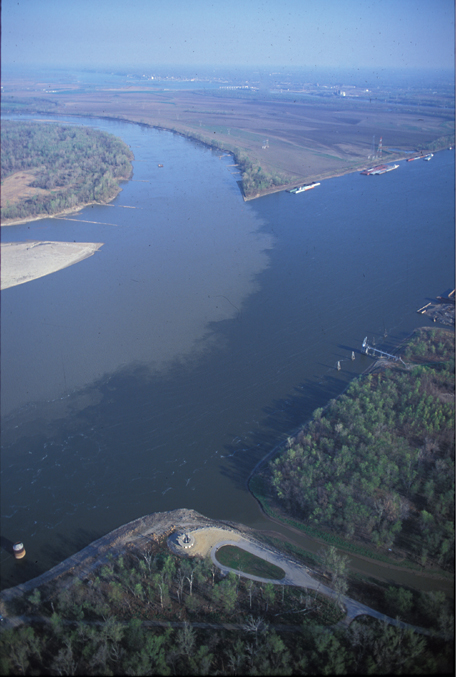Sometime before they sailed west on 14 May 1804, Clark recorded: “Capts. Lewis & Clark wintered at the enterance of a Small river opposite the Mouth of Missouri Called wood River, where they formed their party, Composed of robust Young Backwoodsmen of Character.” Reconsidering the difficult hours some of those “characters” had caused him with their resistance to the rigorous military disipline imposed upon them, he crossed out the last four words and substituted, “healthy hardy young men.”
The expedition began building their winter camp on 13 December 1803. Owing to the shifting of the rivers’ confluence, the actual site has never been determined. One study places it near the left side of the bridge at the top center of this photo.
On their return, after spending the night of 22 September 1806 at the recently built Fort Bellefontaine (in the photo, a few miles around the bend at left), the Corps revisited the Wood River camp. There, according to Sergeant Ordway, they called on the widow who had worked for them during the winter of 1803-04, and who now had “a plantation under tollarable good way.” Her name is unknown.
The mouth of the river once named for a settler named Dubois is only about a mile south of its 1803 location, but the Missouri and Mississippi Rivers have moved their meeting-place about three miles south over the past 200 years. No one can be certain where the camp was, but educated guesswork places it today on the Missouri side of the Mississippi, on Maple Island near the north bank of the big, flat floodplain called Mobile Island, downstream from the bridge at extreme upper center.
Opposite the Missouri’s muddy mouth, in a compromise between history and hydrology, the commemorative observation point at lower center is situated at the mouth of the Cahokia Diversion Channel, which combines the waters of Cahokia and Indian Creeks. For a view of the merging of the two rivers in the 1880s, see The Mouth of the Missouri.
Commercial river traffic in the vicinity of Camp Wood was comparatively heavy even back in the decade of the Expedition, and the two rivers are still highroads for shipment of bulk commodities such as the petroleum that’s loaded onto barges from the refineries at the nearby city of Wood River, Illinois, through pipelines leading to the terminals at center right.
From Discovering Lewis & Clark from the Air
Photography by Jim Wark
Text by Joseph Mussulman
Reproduced by permission of Mountain Press
Experience the Lewis and Clark Trail
The Lewis and Clark Trail Experience—our sister site at lewisandclark.travel—connects the world to people and places on the Lewis and Clark Trail.
Discover More
- The Lewis and Clark Expedition: Day by Day by Gary E. Moulton (University of Nebraska Press, 2018). The story in prose, 14 May 1804–23 September 1806.
- The Lewis and Clark Journals: An American Epic of Discovery (abridged) by Gary E. Moulton (University of Nebraska Press, 2003). Selected journal excerpts, 14 May 1804–23 September 1806.
- The Lewis and Clark Journals. by Gary E. Moulton (University of Nebraska Press, 1983–2001). The complete story in 13 volumes.


